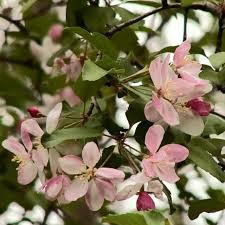Crabapple
Malus coronaria
Overview
The Native Crabapple, also known as the Wild Crabapple or Sweet Crabapple, has fragrant, white to white-pink blossoms that are one of the last crabapples to bloom, typically mid-spring. Reaching 25 feet tall and 35 feet wide, the fall color of the Native Crabapple is usually green to chartreuse, but can also contain leaves that tend to show a brighter yellow. It has a short trunk and is often crooked with a broad irregular crown. The tree is compactly branched and thorny. It can also form a colony with age.
Cultivation
The Native Crabapple likes either sun or partial shade and moist, well-drained soil. However, the tree adjusts to dynamic variations in conditions and soils. When the tree is close to Junipers, an alternate host to rust, cedar-apple rust is a problem. If you plant the tree at least 500 feet from cedars, this should not prove to be an issue.
Biodiversity Sustained
The fruits that Crabapples produce are bitter but can make tasty jelly or jam. Bees, butterflies, birds, and more use the tree as both a food source and a nesting site. While rabbits and deer browse the foliage, the Native Crabapple is prone to many diseases and pests which can directly affect the foliage and fruits.
On Xavier's Campus, over the Next 20 Years, this Tree will:
Stormwater Runoff Intercepted: 3,865 Gallons
CO2 Reduction: 2,818 lbs
Environmental Benefits (in US dollars): $191
